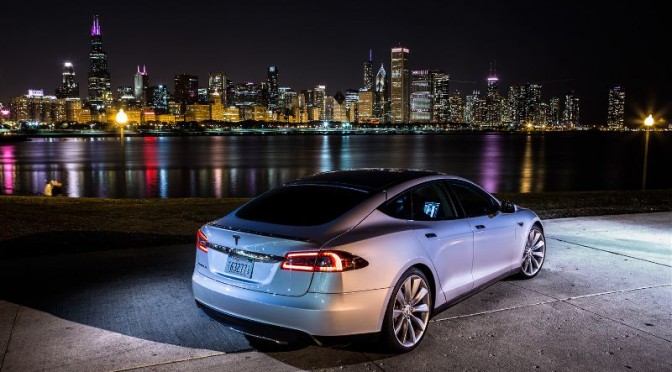Tesla Motors repaid the entire remaining balance on a $465 million loan from the Department of Energy nine years earlier than originally required. U.S. Energy Secretary Ernest Moniz made the following statement: “When you’re talking about cutting-edge clean energy technologies, not every investment will succeed — but today’s repayment is the latest indication that the Energy Department’s portfolio of more than 30 loans is delivering big results for the American economy while costing far less than anticipated.
“More than 90 percent of loan loss reserve Congress established remains intact, while losses to date represent about 2 percent of the overall $34 billion portfolio. The other 98 percent of the portfolio includes 19 new clean energy power plants that are adding enough solar, wind and geothermal capacity to power a million homes and displace 7 million metric tons of carbon dioxide every year – roughly equal to taking a million cars off the road.
“The Department first offered loans to Tesla and other auto manufacturers in June 2009, when car companies couldn’t get other financing and many people questioned whether the industry would survive. Today, Tesla employs more than 3,000 American workers and is living proof of the power of American innovation. This is another important contribution to what the Obama Administration has done to preserve and promote America’s auto industry.
“Finally, this announcement is also good news for the future of America’s growing electric vehicle industry. While the market has taken longer than predicted to get going, sales of electric vehicles in the U.S. tripled last year and are continuing to increase rapidly in 2013. Tesla and other U.S. manufacturers are in a strong position to compete for this growing global market.”
The Department released today a fact sheet providing additional statistics and highlights of the Department’s loan portfolio.
Key Statistics and Highlights of the Department’s Loan Portfolio:
Losses to date in the Department’s loan programs represent about 2 percent of the $34 billion portfolio and less than 10 percent of the $10 billion loan loss reserve that Congress set aside to cover expected losses in the programs.
Many of the nation’s largest and most innovative energy and transportation projects are supported by the Department of Energy’s loan programs, including:
- Several of the world’s largest solar generation facilities and thermal energy storage systems (Ivanpah, Agua Caliente, Desert Sunlight, Abengoa Solana, and Solar Reserve Tonopah)
- One of the world’s largest wind farms (Shepherds Flat)
- The first two all-electric vehicle manufacturing facilities in the U.S. (Tesla and Nissan)
- The first nuclear power plant to be built in the U.S. in the last 30 years (Vogtle)
In the auto industry specifically, these investments have made an enormous impact. In June 2009, for example, the Department offered more than $8 billion in conditional loan commitments to three companies — Ford, Nissan and Tesla – to help retool, refurbish, and reopen American auto plants to produce the cars of the future. The results have been impressive:
- The Department provided a $5.9 billion loan to Ford Motor Company to upgrade and modernize thirteen factories across six states and to introduce new technologies to raise the fuel efficiency of more than a dozen popular vehicles, including C-Max Hybrid, Focus, Escape, Fusion, Taurus, and F-150 trucks, representing approximately two million new vehicles annually. This investment is supporting approximately 33,000 manufacturing and engineering jobs across the United States.
- In Smyrna, Tennessee, the first advanced battery packs produced in the United States are coming off the production line of Nissan North America’s production plant. These advanced batteries are powering U.S.-made all electric Nissan LEAF cars. The construction of the 1.3-million-square-foot, state of the art battery facility was made possible through a $1.4 billion loan from the Department of Energy.
- Tesla’s $465 million loan enabled it to reopen a shuttered auto manufacturing plant in Fremont, California and to produce battery packs, electric motors, and other powertrain components. Tesla vehicles have won wide acclaim, including the 2013 Car of the Year from both Motor Trend and Automotive Magazine, and Consumer Reports recently rated Tesla’s Model S as tied for the best car ever rated. Tesla has created more than 3,000 full-time jobs in California – far more than the company initially estimated – and is building out a supply chain that supports numerous additional jobs and technologies, and is bringing advanced manufacturing technology back to America.
It’s important to remember that these three loans were conditionally offered in June 2009, which was a time when many people believed that the industry itself might not survive. That was the same month GM filed for bankruptcy, and auto sales were 28 percent lower than the year before. One major newspaper headline that month summed up the industry as “on the verge of extinction.” June 2009 was also the lowest point for U.S. auto industry employment in decade. At the beginning of 2008, America’s auto industry had employed almost a million people; just 18 months later, one-third of those jobs were gone. The ongoing financial crisis was making it nearly impossible for the major auto companies – let alone startups like Tesla – to obtain financing. The lack of financing for the automotive industry was critical and potentially lethal for the industry. Providing these loans was a calculated risk – but it was the right decision for the country.
http://santamarta-florez.blogspot.com.es/2013/05/tesla-fabricante-de-vehiculos.html


